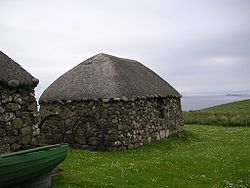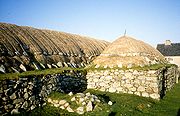
Black house
Encyclopedia

Scottish Highlands
The Highlands is an historic region of Scotland. The area is sometimes referred to as the "Scottish Highlands". It was culturally distinguishable from the Lowlands from the later Middle Ages into the modern period, when Lowland Scots replaced Scottish Gaelic throughout most of the Lowlands...
of Scotland
Scotland
Scotland is a country that is part of the United Kingdom. Occupying the northern third of the island of Great Britain, it shares a border with England to the south and is bounded by the North Sea to the east, the Atlantic Ocean to the north and west, and the North Channel and Irish Sea to the...
, the Hebrides
Hebrides
The Hebrides comprise a widespread and diverse archipelago off the west coast of Scotland. There are two main groups: the Inner and Outer Hebrides. These islands have a long history of occupation dating back to the Mesolithic and the culture of the residents has been affected by the successive...
, and Ireland
Ireland
Ireland is an island to the northwest of continental Europe. It is the third-largest island in Europe and the twentieth-largest island on Earth...
.
Origin of the name
The origin of the name blackhouse is of some debate. It could be less than 150 years old and may have been synonymous with inferior. On Lewis, in particular, it seems to have been used to distinguish the older blackhouses from some of the newer white-houses , with their mortared stone walls. There may also be some confusion arising from the phonetic similarity between the dubh, meaning black and tughadh meaning thatch.The houses in Scotland were built high rather than wide; however, some were built small and wide.
Description
The buildings were generally built with double wall dry-stone walls packed with earth and wooden rafters covered with a thatch of turf with cereal straw or reed. The floor was generally flagstoneFlagstone
Flagstone, is a generic flat stone, usually used for paving slabs or walkways, patios, fences and roofing. It may be used for memorials, headstones, facades and other constructions. The name derives from Middle English flagge meaning turf, perhaps from Old Norse flaga meaning slab.Flagstone is a...
s or packed earth and there was a central hearth for the fire. There was no chimney for the smoke to escape though. Instead the smoke made its way through the roof.
The black house was used to accommodate livestock as well as people. People lived at one end and the animals lived at the other with a partition between them.
Lewis blackhouse

The blackhouses on the Isle of Lewis have roofs thatched with cereal straw over turf and thick, stone-lined walls with an earthen core. Roof timbers rise from the inner face of the walls providing a characteristic ledge at the wall head (tobhta). This gives access to the roof for thatching. Both the animals and occupants shared the same door, living at different ends of the same space. Several long ranges, or rooms, were usually built alongside each other, each one having its own ridgeline giving them the very distinctive look of the Lewis blackhouse.
The immediate origins of the blackhouse are unclear as few pre-eighteenth century examples have ever been excavated. One reason for this is that, unlike their later counterparts, the early examples may have been made of turf and thatch and quickly returned to the earth once abandoned. As one of the most primitive forms of the North Atlantic longhouse tradition it is very probable that the roots of the blackhouse, in which cattle and humans shared the same roof, is well over 1000 years old. The Lewis examples have clearly been modified to survive in the tough environment of the Outer Hebrides. Low rounded roofs, elaborately roped were developed to resist the strong Atlantic winds and thick walls to provide insulation and to support the sideways forces of the short driftwood roof timbers.
External links
- Lewis Black House Museum
- Gearrannan Blackhouse Village
- Highland Village Museum / An Clachan Gàidhealach, Iona, Nova Scotia
- The Blackhouse of the Highlands on "Dualchas Building Design" with good drawings and plans.

